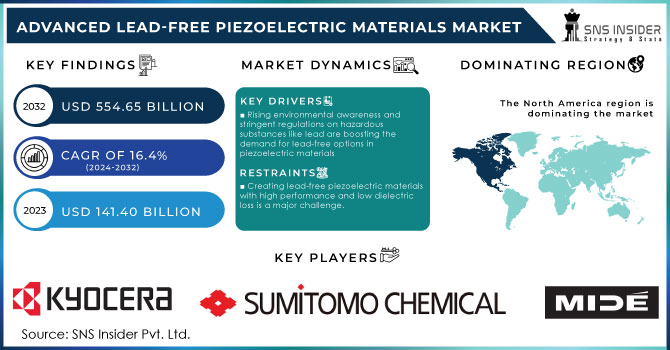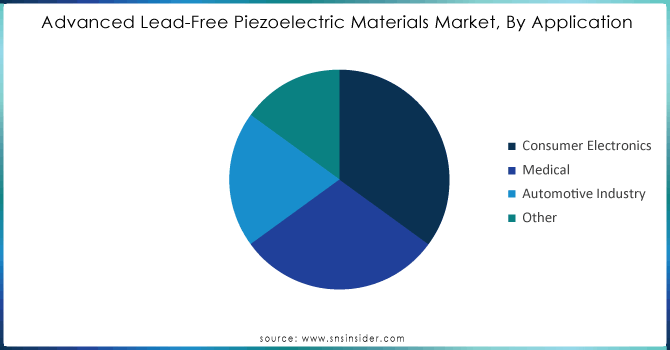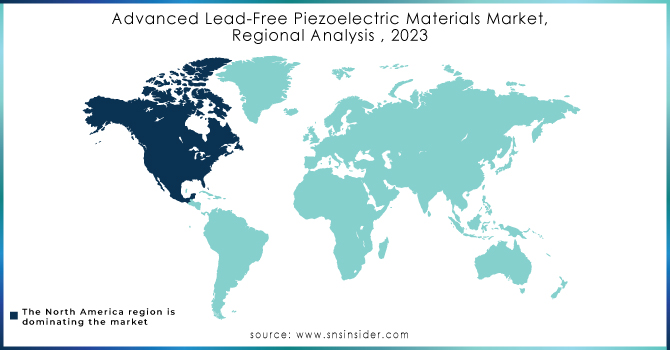Advanced Lead-Free Piezoelectric Materials Market Size

Get More Information on Advanced Lead-Free Piezoelectric Materials Market - Request Sample Report
The Advanced Lead-Free Piezoelectric Materials Market was valued at USD 145.10 Billion in 2023 and is projected to reach USD 558.75 Billion by 2032, growing at a robust CAGR of 16.17% during the forecast period from 2024 to 2032.
Advanced Lead-Free Piezoelectric Materials Market is primarily grow by global environmental concerns and strict regulations against hazardous materials, particularly lead. This drive has prompted extensive research and innovation to develop environmentally friendly alternatives.
Additionally, the expanding applications of these materials across industries such as electronics, automotive, aerospace, and energy harvesting contribute significantly to market expansion. Technological advancements have also improved the performance and properties of these materials, including enhanced piezoelectric coefficients and higher Curie temperatures, ensuring optimal functionality across various operating conditions. Lead is identified by the United Nations Environment Programme (UNEP) as a significant public health concern due to its detrimental effects on health. Exposure to lead can result in severe health issues, prompting various countries to enforce stringent regulations on lead-based materials. Recent research featured in the "Advanced Materials" journal showcases progress in lead-free piezoelectric materials, achieving piezoelectric coefficients surpassing 600 pm/V, which is notable enhancement from previous materials. Consequently, this technological advancement, coupled with regulatory measures, is expected to propel the revenue growth of the Advanced Lead-Free Piezoelectric Materials market.
| Report Attributes | Details |
|---|---|
| Key Segments | • By Type (Composites, Ceramics & Others) • By Application (Medical, Automotive Industry Consumer Electronics & Other) |
| Regional Coverage | North America (US, Canada, Mexico), Europe (Eastern Europe [Poland, Romania, Hungary, Turkey, Rest of Eastern Europe] Western Europe] Germany, France, UK, Italy, Spain, Netherlands, Switzerland, Austria, Rest of Western Europe]), Asia Pacific (China, India, Japan, South Korea, Vietnam, Singapore, Australia, Rest of Asia Pacific), Middle East & Africa (Middle East [UAE, Egypt, Saudi Arabia, Qatar, Rest of Middle East], Africa [Nigeria, South Africa, Rest of Africa], Latin America (Brazil, Argentina, Colombia, Rest of Latin America) |
| Company Profiles | Electronic Ceramic, Kyocera, Sumitomo Chemica, PI Ceramic GmbH, Yuhai, APC International, Ltd, Peizo Kinetics, Inc, Mide Technology Corporation., EBL Products, LLC |
MARKET DYNAMICS
KEY DRIVERS:
-
Rising environmental awareness and stringent regulations on hazardous substances like lead are boosting the demand for lead-free options in piezoelectric materials
Growing awareness of environmental sustainability and strict regulations on hazardous substances, such as lead, are pushing for lead-free alternatives in piezoelectric materials. Additionally, continuous advancements in materials science have greatly enhanced the performance and properties of these lead-free materials. Improved piezoelectric coefficients and higher Curie temperatures have made them more efficient and versatile for various applications.
-
Lead-free piezoelectric materials are used in electronics, automotive, aerospace, and energy harvesting because they efficiently convert mechanical energy into electrical energy, functioning in sensors, actuators, and energy harvesters
RESTRAIN:
-
Developing lead-free alternatives that can match the performance of lead-based piezoelectric materials, particularly in terms of high piezoelectric coefficients and low dielectric loss, is proving to be a major challenge
Creating lead-free piezoelectric materials that can match the performance of lead-based ones, especially in terms of high piezoelectric coefficients and low dielectric loss, is tough. Moreover, making these advanced lead-free materials often costs more than producing traditional lead-based ones. This price gap can make it hard for them to be widely used, especially in applications where cost is a big factor.
-
Lead-free piezoelectric materials' complex compositions and processing methods can complicate manufacturing, leading to challenges in scaling up production while maintaining consistent quality and performance
OPPORTUNITY:
-
Increasing environmental regulations are driving demand for lead-free options, giving manufacturers a chance to create and sell advanced lead-free piezoelectric materials meeting compliance standards
Global environmental rules want lead-free options, letting makers create and sell advanced lead-free piezoelectric materials meeting standards. Research is improving these materials, helping firms offer better, cheaper options. Piezoelectric materials are used in sensors, actuators, and medical gear, spurring demand for lead-free versions, especially in new areas like wearables and IoT.
-
Rising demand for piezoelectric materials in developing countries, alongside infrastructure growth and technological progress, allows companies to grow their market reach and explore new markets for expansion
CHALLENGES:
-
Lead-free piezoelectric materials often struggle to match the performance and efficiency of traditional lead-based counterparts, facing challenges in achieving comparable piezoelectric properties such as high coefficients and low mechanical losses
Lead-free piezoelectric materials struggle to match the performance and efficiency of traditional lead-based counterparts, facing challenges in achieving comparable piezoelectric properties such as high coefficients and low mechanical losses. Ensuring the long-term stability and reliability of these materials is crucial for their commercial adoption, necessitating consistent performance over time and various environmental conditions, which can be difficult due to material degradation or phase transitions.
Impact Of Russia Ukraine War
The impact of the Russian-Ukraine war on the advanced lead-free piezoelectric materials market depends on the type of materials and their uses. For composite materials, supply disruptions from Ukraine could cause shortages or higher prices, prompting companies to seek new suppliers. Ukraine's ceramic industry could face challenges, affecting the production and cost of piezoelectric ceramics, potentially spurring innovation elsewhere. If Russia or Ukraine supplies other materials like polymers, disruptions could increase costs and deter investment. In medical fields, supply interruptions might affect devices like ultrasound machines, while innovation could arise to find alternatives. The automotive industry, relying on piezoelectric materials for various components, may face delays or cost increases, leading to a search for new sources. Similarly, disruptions could impact the production of consumer electronics, potentially raising prices or prompting innovation to reduce reliance on affected regions.
Impact of Economic Slowdown
The economic slowdown of the advanced lead-free piezoelectric materials market refers to a decrease in its growth and activity. This slowdown can happen due to various factors, such as reduced demand for products using these materials, disruptions in the supply chain, or economic uncertainty affecting investment and spending. When businesses face challenges in sourcing materials or uncertainty about future market conditions, they may delay or scale back their production plans, leading to a slowdown in the market. Additionally, if consumers are hesitant to spend on products incorporating these materials due to economic concerns, it can further dampen demand. Overall, an economic slowdown in the advanced lead-free piezoelectric materials market means a period of decreased growth and activity for businesses involved in producing and using these materials.
KEY MARKET SEGMENTS
By Type:
-
Composites
-
Ceramics
-
Others
In the segmentation of the Advanced Lead-Free Piezoelectric Materials Market, three main types are identified: Ceramics, Composites, and Others. Among these, ceramics stand out as the dominant segment, contributing to over half of the market revenue. Ceramics are preferred for their outstanding piezoelectric characteristics, boasting high piezoelectric coefficients that make them well-suited for diverse applications. Widely utilized in consumer electronics, automotive sensors, and industrial settings, ceramics excel in converting mechanical vibrations into electrical energy efficiently.
By Application:
-
Medical
-
Automotive Industry
-
Consumer Electronics
-
Other
The Advanced Lead-Free Piezoelectric Materials Market is segmented by application into Medical, Automotive Industry, Consumer Electronics, and Other sectors. These materials find extensive use in various fields such as medical devices, automotive components, and consumer electronics like smartphones and tablets. Additionally, they are applied in other industries for diverse purposes.

Get Customized Report as per Your Business Requirement - Request For Customized Report
REGIONAL ANALYSIS
-
The North America region is first to dominate the Advanced Lead-Free Piezoelectric Materials market due to its leadership in technological advancements and innovations within the piezoelectric materials sector. Moreover, the region's market demand for lead-free materials is bolstered by stringent environmental regulations and consumer preferences favoring sustainable products.
-
The Europe Advanced Lead-Free Piezoelectric Materials market holds the position as the second-largest market globally. European nations have a longstanding commitment to environmental sustainability, often implementing strict regulations regarding hazardous substances like lead. This regulatory framework has expedited the advancement and integration of lead-free piezoelectric materials across multiple industries.
-
The Asia-Pacific is take growing role in Advanced Lead-Free Piezoelectric Materials Market is expected to see the fastest growth rate from 2024 to 2031. This region is a key hub for making consumer electronics and automotive parts, which depend a lot on piezoelectric materials. Also, because of big investments in research and development and a large number of consumers, there's a growing demand for these materials in the Asia-Pacific region.

REGIONAL COVERAGE:
North America
-
US
-
Canada
-
Mexico
Europe
-
Eastern Europe
-
Poland
-
Romania
-
Hungary
-
Turkey
-
Rest of Eastern Europe
-
-
Western Europe
-
Germany
-
France
-
UK
-
Italy
-
Spain
-
Netherlands
-
Switzerland
-
Austria
-
Rest of Western Europe
-
Asia Pacific
-
China
-
India
-
Japan
-
South Korea
-
Vietnam
-
Singapore
-
Australia
-
Rest of Asia Pacific
Middle East & Africa
-
Middle East
-
UAE
-
Egypt
-
Saudi Arabia
-
Qatar
-
Rest of Middle East
-
-
Africa
-
Nigeria
-
South Africa
-
Rest of Africa
-
Latin America
-
Brazil
-
Argentina
-
Colombia
-
Rest of Latin America
Key Players
Some of the major players in the Advanced Lead-Free Piezoelectric Materials Market Electronic Ceramic, Kyocera, Sumitomo Chemica, PI Ceramic GmbH, Yuhai, APC International Ltd, Peizo Kinetics, Inc, Mide Technology Corporation., EBL Products, LLC, and other players.
RECENT DEVELOPMENTS:
-
March 2024 The individuals or entities responsible for this development could include researchers, scientists, engineers, or companies specializing in materials science or ceramics. Developing The highly saturated poling in lead-free piezoceramics for giant energy conversion is achieved through multiscale reconfiguration. Creating high-performance lead-free K0.5Na0.5NbO3-based piezoceramics to replace existing lead-containing options is essential for building an environmentally sustainable society. While the introduction of new phase boundaries (NPB) has shown promise in enhancing the piezoelectric properties of KNN-based ceramics, challenges remain in achieving fully saturated poling and resolving the complex microstructures at multiscale levels.
-
March 2024 Global Market Insights Inc. The Piezoelectric Ceramics Industry is projected to experience a 5.3% Compound Annual Growth Rate (CAGR) from 2024 to 2032, driven by the expanding electronics sector. Industries are increasingly seeking sustainable alternatives due to strict environmental regulations and changing consumer preferences, with a growing demand for eco-friendly options driven by heightened awareness of environmental impacts. In 2023, 49% of organizations introduced climate-friendly offerings, according to Travel Perk data.
| Report Attributes | Details |
| Market Size in 2023 | US$ 141.4 Billion |
| Market Size by 2032 | US$ 554.65 Billion |
| CAGR | CAGR of 16.4 % From 2024 to 2032 |
| Base Year | 2023 |
| Forecast Period | 2024-2032 |
| Historical Data | 2020-2022 |
| Report Scope & Coverage | Market Size, Segments Analysis, Competitive Landscape, Regional Analysis, DROC & SWOT Analysis, Forecast Outlook |
| Key Drivers | • Rising environmental awareness and stringent regulations on hazardous substances like lead are boosting the demand for lead-free options in piezoelectric materials. • Lead-free piezoelectric materials are used in electronics, automotive, aerospace, and energy harvesting because they efficiently convert mechanical energy into electrical energy, functioning in sensors, actuators, and energy harvesters. |
| Challenges | • Lead-free piezoelectric materials often struggle to match the performance and efficiency of traditional lead-based counterparts, facing challenges in achieving comparable piezoelectric properties such as high coefficients and low mechanical losses. |

